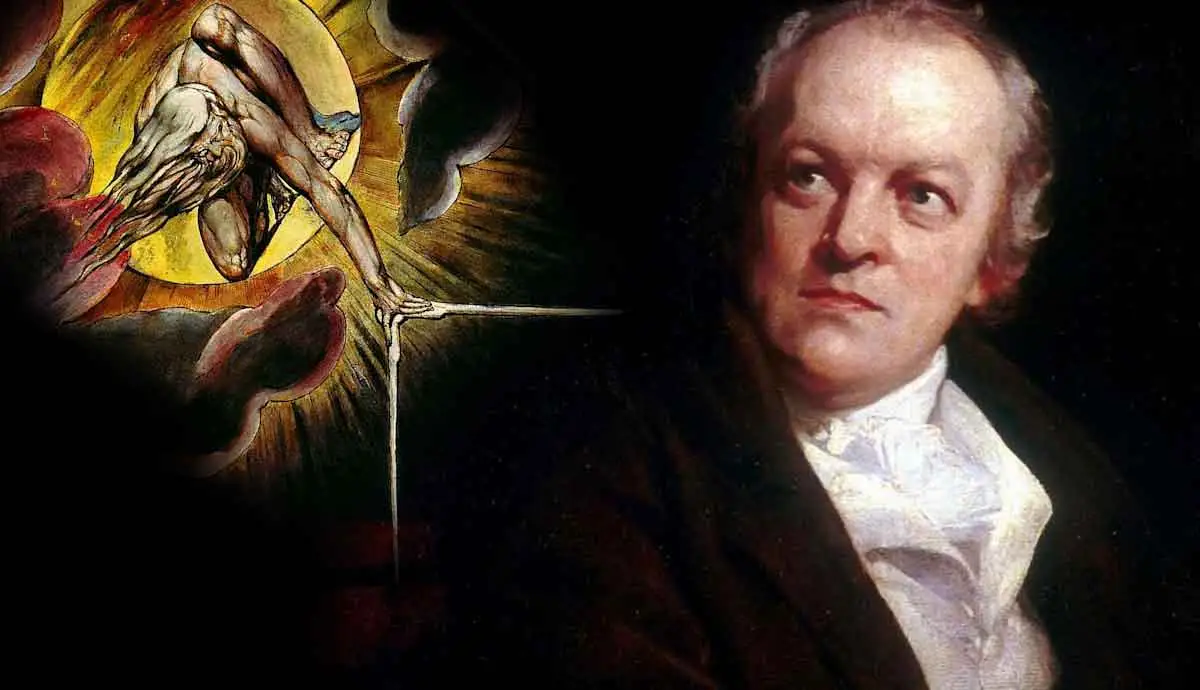William Blake’s Universe, the new (free) exhibition at the Fitzwilliam Museum in Cambridge, is a celebration of work by the Romantic artist, writer and visionary.
Famous now but little known in his lifetime, Blake (1757-1827) has been given star billing by Tate Britain recently. But at the Fitzwilliam, he is made to share the spotlight with fellow artists from Britain and Germany, notably Philipp Otto Runge (1777-1810), whose luminous The Small Morning hangs in the exhibition’s final room.
The approach of exhibition curators David Bindman and Esther Chadwick is quietly provocative. Blake is known tb as a poet, he never left Britain, and he never met Runge. He was also a contrarian, with broadly anti-establishment views. So what is at stake in reframing Blake as a European artist, and does the exhibition convince?
The exhibition’s title and the life-sized cast of Blake’s head that greets you as you enter, suggest its aim will be to present a trip inside his mind. And to an extent, it does. The bulk of work on display is by Blake himself, much of it drawn from the Fitzwilliam Museum’s own magnificent collection.
Particular highlights are Blake’s glowing drawing Albion Rose and the mysterious Ancient of Days, his beautifully coloured, hand-printed poems America and Europe, and his energetic re-interpretations of ancient Greek sculptures like the Laocoön.
Also on display are spectacular works by other artists, including Benjamin West’s Death on the Pale Horse and Caspar David Friedrich’s series of seven sketches in sepia, Ages of Man (Die Lebensalter).
Evidently this “universe” does not belong to Blake alone. It is rather a shared imaginative and cultural space, inhabited by Blake and other Romantic artists across Europe from the 1770s to the 1820s.
Portraits of the main players appear in the exhibition’s ante-room. First Runge, whose soulful self-portrait is twinned with Blake’s life mask at the entrance. Then John Flaxman, James Barry, and Henry Fuseli, whom Blake knew personally, and Asmus Jacob Carstens and Caspar David Friedrich, whom he did not.
It is revelatory to see Blake in the company of artists like these. Poems like The Tyger, London and the verse And did those feet (better known as the hymn Jerusalem, after it was set to music by Hubert Parry in 1916), mark Blake out as a poet.
In fact he was this and more. The online William Blake Archive hints at the range of his work rendered in text, engraving, printmaking, drawing and painting.
It was rare for Blake to write a poem without illustrating it. Working with his wife Catherine, he hand-engraved, hand-coloured and hand-printed “illuminated books” of his verses, releasing dozens of copies over his lifetime essentially as small press editions.
However, he made his living creating and selling visual art – engravings and book illustrations – to commercial publishers. He also produced single and serial works of art for private patrons.
Blake aspired to be better known as an artist (and writer too), and to share his work with a larger audience. But his career floundered, hampered by the precariousness of the art market during the Napoleonic wars, the low social status of his commercial engraving, and his contrary views.
The bold exhibition design ensures there is a strong central narrative. Each room focuses on the engagement by European artists with the past, present and future.
The past is that of classical antiquity and the old masters, whose works were copied and repurposed by artists across Europe as they honed their skills in academy schools. The present is that of war and revolution, in America, France and Haiti. The future is that of spiritual renewal, conceived of variously in mystical, Christian, pantheistic and nationalist terms.
Within this historical narrative are clustered smaller scenes which reward attentive viewing. Sketches after Michelangelo, visits to a leper hospital, and the mystical Christian philosophy of Jakob Böhme are just some of the themes identified and shown to be common concerns among what initially may seem like a disparate group of artists.
The exhibition architecture invites active engagement too. Separated pages of Blake’s illuminated book, Europe, are displayed on a corrugated screen zig-zagging across the central room, jagged as a bolt of lightning – a phenomenon associated with political revolution.
Early on in the exhibition, a window is cut from the “past” to the “future”, complicating the historical narrative. Is it true that we always progress, that things always get better?
Blake never had the funds to travel to mainland Europe, nor was he sponsored by one of his patrons to go to Rome. He also never read German, although he did learn Italian later in life, and illustrated Dante.
He was not, like Samuel Taylor Coleridge, influenced by German idealist philosophy. But to be schooled at the Royal Academy, as Blake was from 1779 to 1785, was to learn from European models. And to have a Moravian (a type of Protestant) mother may have included learning German songs and hymns in childhood.
The Bible, Dante, Shakespeare, the mystics Böhme and Emanuel Swedenborg were all favourites of Blake’s, and commonly read across continental Europe. Add to this the reverberations of revolution, war, trade, imperialism – all of which sound in Blake’s art and poetry – and it’s clear that Blake was not insular in his outlook.
The question of Blake’s Europeanness is posed everywhere in this exhibition, but never overtly. The working title “Blake in Europe”, was lost along the way. Never quite asked are further questions about the limits of the shared European Romantic culture that the exhibition promotes. Which culture, or cultures, you could ask, and whose?
As Sibylle Erle, Chair of the Blake Society has said: “For us, Blake is for everybody.” Go to William Blake’s Universe if you can, and see what you think.





















